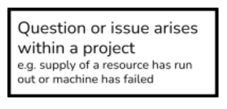Introduction
Given technological advances over the last 10 years within the artificial intelligence and machine learning areas, there has been tremendous debate over the upcoming trajectory of artificial intelligence.
One of the meta questions associated with this discussion is what is going to happen to people’s jobs once this level of ‘competence’ is realised.
There is a long way to go before artificial general intelligence is achieved but we are already starting to see some peripheral ways in which ‘computers’ are replacing aspects of people’s jobs. These may or may not utilise AI/ML in so doing but since the end is the same, I wanted to take some time to look at nuances between the means.
Also, an apology for all the quotation marks. In a number of instances the words used are loaded and I wanted to highlight where they may not have the same application in this context versus common or literal definitions.
So, what is the difference between workflow automation and robotic process automation?
Workflow automation is associated with how a piece of work moves through its various stages, whereas robotic process automation relates to how one stage within that process is handled.
That is the primary distinction, so feel free not to continue but if you want an example, below is this point expanded.
Workflow automation
Below is an example of a simplified process where a piece of work moves through different parties and stages in its completion.

Obviously the below is a very simplified version of a workflow, which could be anything from someone opening an account at a bank through to a product being sold in stores (through the stages of design, prototyping, production, distribution). One can also imagine these issues happening, tens, hundreds or thousands of times every day.
Having an efficient and robust process for movement is key to achieving optimised operating outcomes.
The ways in which this piece of work moves through the different stages in this simplified process could be any of the following:
- Email
- Telephone
- Message e.g. WhatsApp/Slack/SMS etc.
Then what happens if the person is not there, or misses the email. Also who keeps the record of approval having been provided? Do you have reminders set up to chase in case there is no instant feedback? How can third parties see the audit trail when e.g. approvals or emails sit outside the system?
All the above issues are solvable. Whether it is via sensors, email ‘listeners’, reminder notifications, audit logs or other means, the technology exists to provide solutions to all these real world issues. By seamlessly (i.e. automatically) moving information from one point to another based on input you can not only consolidate information in one place but also increase the speed of its transitions.
Robotic Process Automation
For robotic process automation, let’s instead just focus on one stage of this workflow, the first one.

For this step in the process, we can think of either a piece of equipment failing within a manufacturing environment, or a computing process failing as a result of issues in the code. In both these cases, a manual process - for example, visual inspections of the equipment itself or the output of that equipment in the case of the manufacturing environment, or manual testing (running the programs) in the case of the developers - can be swapped for automated steps: either sensor inputs or an automated testing framework .
For example, by establishing thresholds or tests for the sensors or ‘cron jobs’ for the automated testing framework, you have just turned a manual process into a ‘robotic’ one.